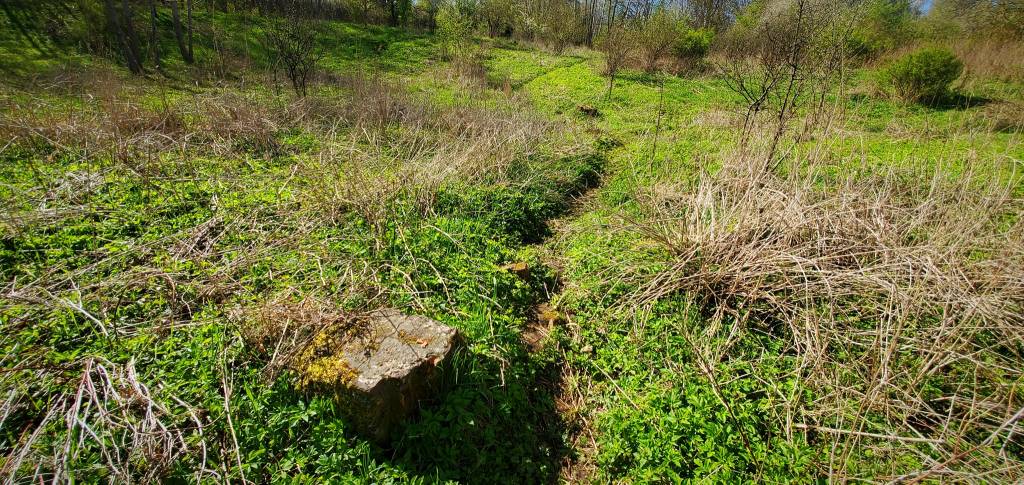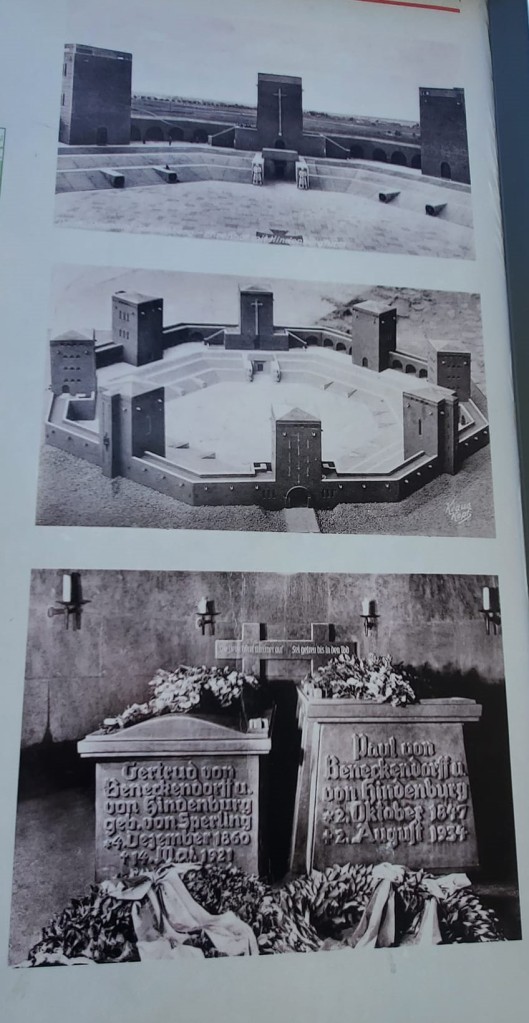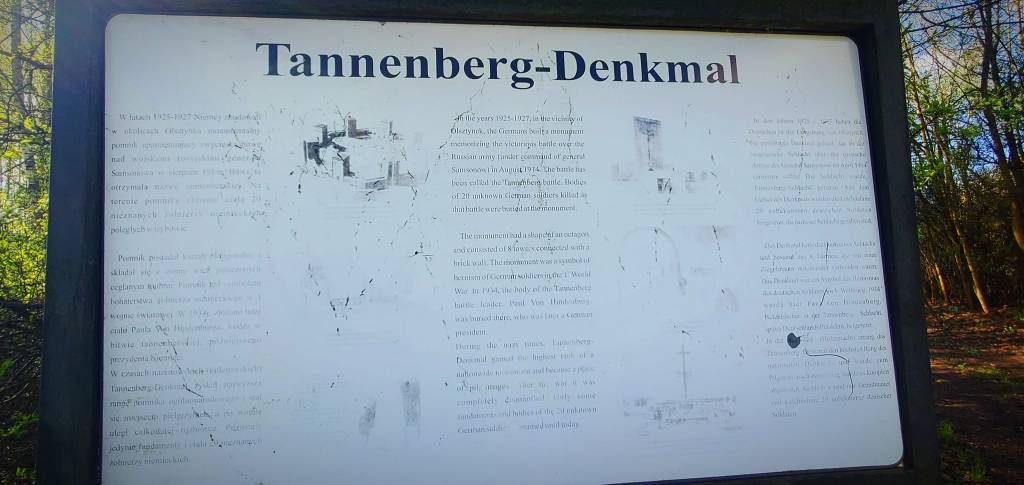Finding something that no longer exists is difficult, but not impossible. This was the situation my travel companion and I faced on the edge of Olstynek as we searched for the Tannenberg Memorial’s location. We were on a mission to see if the invisible could be rendered visible. Over a forty-year period beginning in 1945, the Tannenberg Memorial vanished. The gigantic memorial, which was built to look like a fortress, was attacked by friend and foe. Germans, Soviets, Poles and thousands of looters all played a role in dismantling the memorial.
Now we were coming to visit the vanquished and vanished. Hoping to see some sort of resurrection in the interests of history. This would take imagination and whatever remnants we could piece together in an overgrown field on the outskirts of an obscure town in provincial Poland. That may not sound appealing or promising, but obsessions rarely do for anyone other than the insatiably curious. All we needed was the promise of seeing a few pieces of the past to fire our imagination. Ultimately, this would help us reconstruct the memorial.

Vanishing traces – Path where the Tannenberg Memorial was located
Mortal Danger – The Fascist Beast
By January 1945, Hitler’s Thousand-Year Reich was on the verge of extinction in just its twelfth year. The Germans had already lost the war. It was just a matter of time before Soviet forces overran East Prussia. Their campaign would be particularly vicious since East Prussia was viewed as the heart of German militarism. Red Army soldiers said they were about to enter “the lair of the fascist beast.” The soldiers were hell bent on slaying that beast. Along the way, they would visit destruction on anything in their way. This included not just German soldiers and civilians, but anything that represented German heritage. Places associated with German military prowess did not stand a chance. The Germans knew this meant that the Tannenberg Memorial was in mortal danger.
Germans had inhabited East Prussia since the Teutonic Knights settled there in the early 14th century. Their long and historic occupation of the region was about to suffer the ultimate death sentence. The execution would be administered by the Red Army in an excruciatingly long and drawn-out process. The worst of the process would occur during the first five months of 1945. On January 13th, the Red Army started their offensive in East Prussia. Eight days later, the Germans began to demolish the Tannenberg Memorial. They refused to allow the monument to be overrun by those they considered racially inferior. Instead, they would do much of the dirty work themselves. The Tannenberg Memorial was as much a monument to Teutonic pride as it was to German militarism. It was to be destroyed by the same people who created it. A bit of darkly poetic, prideful justice.

Nationalist intentions – Photos on signboard of the Tannenberg Memorial & Hindenburg tombs prior to demolition
Low Expectations – Remains of War
After being unable to locate the military cemetery supposedly situated just off the highway leading into Olstynek, I was a bit worried that my travel companion and I would have trouble finding where the Tannenberg Memorial once stood. From everything I had read and seen, few traces of the monument still existed. My expectations of what we might find were not optimistic. A few traces would have to satisfy our curiosity. The thoroughness of Germans is legendary. Thus, I assumed they did their best to demolish the monument. The problem for them was that they had little time to complete the job as the Red Army was closing in fast. The Wehrmacht had other priorities, such as the Battle of Berlin. They were also trying to defend Konigsberg, the largest city and provincial capital of East Prussia further to the north. Nevertheless, there was one very important item at Tannenberg that must be removed before the Red Army arrived. These were the remains of Tannenberg’s victorious general, Paul von Hindenburg.
A Prussian soldier par excellence, Hindenburg died in 1934. Adolf Hitler decided against Hindenburg’s wishes that his remains should rest in a mausoleum at the memorial. In January 1945, those same remains were in peril of being desecrated by another eastern invader. Whereas Hindenburg succeeded in rolling the Russian steamroller back from East Prussia at Tannenberg, Hitler’s forces failed to stem the Soviet tide from washing over East Prussia. If Hindenburg’s bones fell into the hands of Red Army soldiers they would never be seen again. The Germans acted quickly to move the remains of Hindenburg and his wife westward just before demolition activity began on the Memorial. The remains eventually made their way westward and fell into the hands of American troops who reburied them at a church in Marburg, where Hindenburg’s ancestors resided.

Fading away – One of the signboards at the Tannenberg Memorial
Last Remains – A Deceptive Impression
Hindenburg’s remains may have been saved, but the Memorial’s fate was sealed. The Germans used explosives to demolish two of its towers, one that served as an entrance and the other which had housed Hindenburg’s remains. They then did the same to other parts of the complex. Due to the size (48 hectares/120 acres) and stoutness of the Memorial’s construction, the Germans were only able to demolish parts of it. Looters would pick over the ruins for years. Some of the ruins were used as a source of building materials in Olsztynek. This is not unlike how Roman ruins were used during the Dark Ages for shelter or construction materials by those in blighted regions of the former empire. The Tannenberg Memorial’s ruins were still being removed forty years after the war. Eventually the site became little more than a vacant field. This was what we had come to see.
Finding the Memorial’s location was not difficult. It was less than a five-minute drive from the center of Olstynek. A grassy road in good condition led to a small parking area. The closest thing representing an entrance to the derelict site were two signboards for Tannenberg-Denkmal (Tannenberg Monument). One was badly faded, while the other looked newer. Beyond those was a grassy field with scattered patches of weeds. The only thing notable about the field was its lack of cultivation. There was nothing particularly striking about the landscape. A faint path led across uneven ground. At first sight, the field bore no traces of the Memorial. We would soon discover that this first impression was deceiving.
Coming soon: An Abandoned Field – Unearthing The Tannenberg Memorial (Poland & Berlin #34b)
